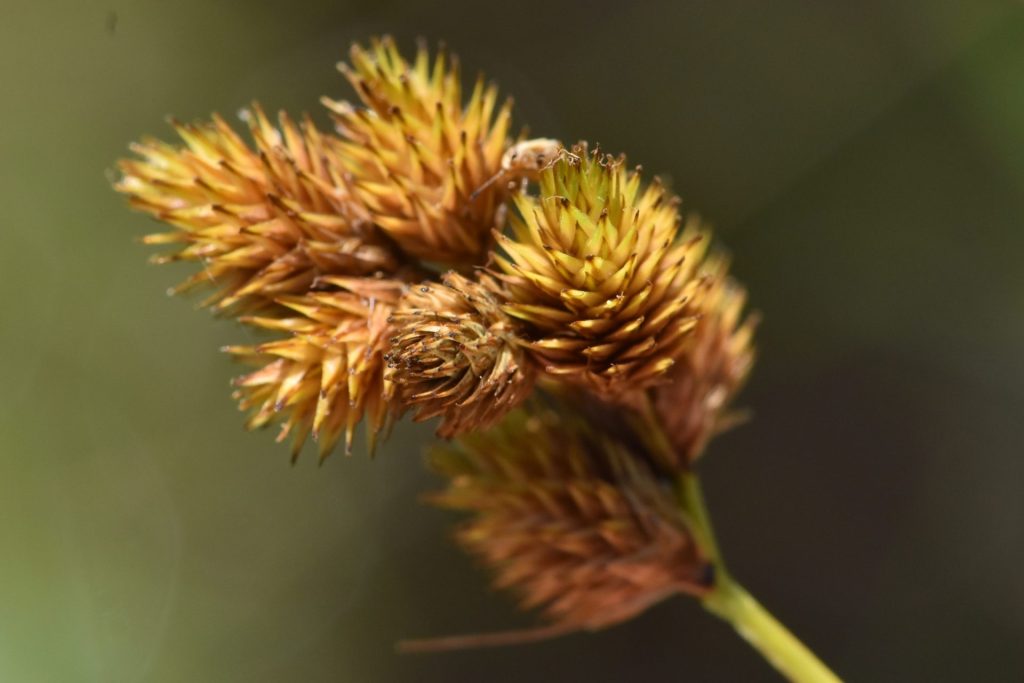
Sedges for Haliburton, Muskoka and Kawartha Lakes
Sedges don’t get much glory. They’re everywhere in Haliburton, Muskoka and Kawartha Lakes but we seldom notice them. If we do notice them, we often confuse them with grasses. It’s time to shine a light on the genus Carex.
Table of Contents
Sedge Basics
What Sedges Are
- Carex (the scientific name for sedges) belongs to the family Cyperaceae.
- There’s a huge variety of sedges. Indeed, Carex is one of the largest genera of flowering plants, with over 2,000 species worldwide.
- In North America alone, there are approximately 480 species.
The Morphology of Sedges
- Sedges are grass-like plants but differ from true grasses in several ways.
- They typically have triangular stems (if you want to recognize them, remember the phrase “sedges have edges”).
- Leaves are arranged in three vertical rows along the stem.
- Flowers are typically small, wind-pollinated, and arranged in spikes or spikelets.
Their Habitat and Distribution
- Sedges are nothing if not versatile. You can likely find one that suits the conditions you have. They’re found in wetlands, forests, prairies…
- They play crucial roles in many ecosystems, often dominating the understory in forests or wetland areas.
Their Ecological Importance
- Many Carex species are important for erosion control and soil stabilization.
- While not a source of pollen, they provide food and habitat for various wildlife species.
- Some species are indicators of specific environmental conditions, making them useful for ecological assessments.
Using Sedges in Native Plant Landscapes
Sedges are one of our favourite types of plants here at Grounded because they’re versatile and can be the basis of the groundcover layer in our designs. Indeed, a garden we installed recently was a “sedge meadow”, consisting of a layer of three Carex species.
Below are some sample sedge species. Note, however, that sedges can fulfill many functions and there are many different conditions that should be taken into account when choosing which species to plant.
In the Groundcover Layer
Many Carex species knit together to form the basis of this fundamental layer in our designs. The more aggressive species can form a mat that completely covers the ground; others are less aggressive and allow room for other species in the same space.
To Control Erosion
Sedges with robust root systems are excellent for stabilizing soil on slopes or along watercourses. Indeed, they fulfil that role in the sedge meadow I mentioned above – it was on a steep slope at risk of washing out in heavy rains.

In Shorelines and Other Wet Areas
Many Carex species tolerate both wet and dry conditions, making them ideal for rain gardens or shorelines that are seasonally flooded. Many other species like to keep their feet wet, so are ideal for marginal areas.



In Woodland Gardens and Shaded Areas
Many of our landscapes are partly shaded. That’s not surprising – our homes and cottages are carved out of the forest. Indeed, if you look at the forest edges, and indeed often deep inside the forest, you’ll sometimes find the only plant surviving on the shaded forest floor is a sedge.

On Septic Beds and Open Areas
While most sedges prefer wetter and shadier conditions, there are some that like it dry and sandy. Septic beds, by their nature, are not damp and it’s important to choose species that won’t go seeking water.

More information
If you really want to get into sedges, read the Mt. Cuba Center sedge study. It focus on sedge species of the Mid-Atlantic Region of the United States, but there is interesting information there nevertheless.
